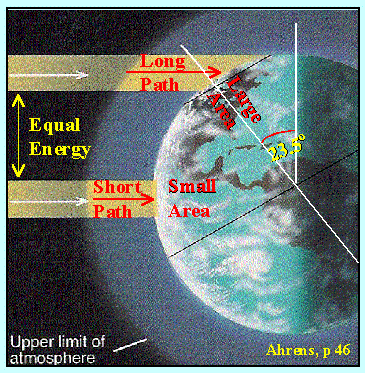| |
|
Solar Radiation

(Click on image to see full-sized) |
Most air quality models need information about the location being studied. For example, in one of the EPA's tropospheric ozone models (EKMA/OZIP), the model requires the value of the solar zenith angle (the angle between the direction of the sun and the zenith (directly overhead, shown in the graphic at left). This value is then used to determine the rate constant for many of the 100+ chemical reactions that are used to describe the chemistry of the atmosphere. Many models, including EKMA/OZIP, determine the solar zenith angle automatically. The analyst typically only needs to
determine the latitude and longitude for the area being studied. Given the location, date, and other data about the area being studied, we can calculate many important and useful datapoints regarding solar radiation. |
For example, the table below shows the results of a calculation for Durham, NC (35.98N, 78.91W) on November 28, 2000 at 3 PM Eastern Standard Time. The amount of solar radiation reported is 1405 W (watts, a unit of power) per square mile. This is roughly 3% more than the solar constant (1367 W/square meters). The solar constant is a global average of solar radiation, including the dark parts of the Earth, so the fact that the radiation is slightly more than the solar constant here during daytime suggests we're in late autumn, afternoon conditions with less sunlight than some parts of the daylit Earth are receiving.
To do this calculation, we used an online solar calculator.
 |
| | Inputs |
| Year | 2000 | | Month | 11 |
| Day | 28 | | Hour | 15 |
| Minute | 0 |
| Latitude | 35 |
| Longitude | -78 |
| Timezone | -5 |
| Pressure | 1013 |
| Temperature | 10 |
| Aspect | 180 | | Solar Constant | 1367 | |
| |
| Outputs |
| Declination (degrees) | -21.4633 |
| Solar Zenith Angle (No refraction) | 70.9488 |
| Solar Zenith Angle (With refraction) | 70.9020 |
| Julian Day | 51877.3333 |
| Equation of Time (minutes) | 11.7954 |
| Hour Angle (degrees) | 44.0388 |
Extraterrestrial
Global Horizontal
Solar Irradiance (W/sq m) | 458.92 |
Extraterrestrial
Direct Normal
Solar Irradiance (W/sq m) | 1405.96 |
| Daily Global ETR (W/sq m) | 4793.9 |
| Daily Direct Normal ETR (W/sq m) | 13762.4 |
| Earth Radius Vector | 1.0285 |
| Sunrise (hour) | 7.1698 | | Sunset (hour) | 16.9584 |
| |
Confused? Have a question? If so, check out the Frequently Asked Questions (FAQ) page or send mail to the OS411 tutor (os411tutor@shodor.org) with your question!
Report technical/content problems here
|
|